"From Passion to Profession: How to Build a Career as a Jewelry Artisan"
- kukkikja
- Oct 17, 2024
- 3 min read
Becoming a jewelry artisan is a journey that combines skill development, creativity, and a deep understanding of materials and techniques. Here's a detailed guide to help you get started:
1. Education and Skill Development:
Learn the Basics: Start with courses in jewelry design, metalworking, or gemology. You can enroll in local workshops, community colleges, or specialized schools. Online courses also offer accessible ways to learn about the craft.
Master Fundamental Techniques: Learn about sawing, soldering, filing, casting, and polishing. Understanding how to work with metals such as gold, silver, and platinum is crucial, as well as knowledge of various gemstones and setting techniques.
Understand Design Principles: Familiarize yourself with jewelry design, including sketching techniques and the use of software like Rhino, Matrix, or Adobe Illustrator. This helps in visualizing and creating complex designs.
2. Practice and Hands-On Experience:
Set Up a Workspace: Invest in basic tools like pliers, saws, files, a bench, and a torch. Start experimenting with making simple pieces, such as rings or pendants, to gain practical experience.
Join Workshops and Classes: Hands-on training through classes or workshops led by experienced jewelers can accelerate your learning.
Experiment with Different Styles and Materials: Work with various metals, stones, and techniques to discover your preferred style and refine your craftsmanship.
3. Apprenticeship and Mentorship:
Seek an Apprenticeship: Find a local jewelry studio, artisan, or jeweler who can mentor you. Apprenticeships allow you to learn the intricacies of the craft and gain insights from professionals.
Network with Experienced Artisans: Join jewelry-making communities, attend trade shows, or participate in jewelry fairs to connect with other artisans.
4. Develop a Unique Style and Build a Portfolio:
Create a Signature Style: Develop a unique design aesthetic that sets you apart from other artisans. This could involve specializing in certain techniques, styles, or materials.
Build a Portfolio: Document your work by photographing finished pieces. Create a digital portfolio or a physical lookbook showcasing your designs, craftsmanship, and unique style.
Participate in Competitions: Enter jewelry design contests or exhibitions to gain exposure and recognition.
5. Get Certified:
Certification Programs: Obtain certifications in jewelry-making, gemology, or specific techniques like metalworking or gemstone setting. Institutions like the Gemological Institute of America (GIA) offer courses in gemology and jewelry design.
Advanced Training: For deeper expertise, consider specialized training in specific areas like CAD (Computer-Aided Design) for jewelry, advanced metalwork, or gemstone cutting.
6. Start Your Business or Freelance Work:
Create a Business Plan: If you intend to sell your jewelry, draft a business plan outlining your target audience, pricing strategies, and marketing approaches.
Set Up an Online Presence: Launch a website or use platforms like Etsy, Instagram, or eBay to showcase and sell your jewelry. Social media is an effective tool for building a brand and reaching potential customers.
Work with Jewelry Stores or Galleries: Collaborate with local boutiques or art galleries to display and sell your work. Wholesale opportunities with jewelry retailers can also be explored.
7. Continual Learning and Improvement:
Stay Updated with Trends and Techniques: Jewelry fashion evolves, and staying informed about current trends, materials, and technological advancements can help keep your skills relevant.
Attend Trade Shows and Seminars: Events like the Bangkok Gems and Jewelry show in Thailand provide opportunities to learn about industry trends and innovations.
8. Understanding Ethical and Sustainable Practices:
Ethical Sourcing of Materials: Learn about ethical sourcing of gemstones and metals. Customers are increasingly concerned about sustainability and the ethical background of materials used in jewelry.
Adopt Sustainable Practices: Explore eco-friendly methods in your production process, such as using recycled metals or conflict-free stones.
Essential Traits and Mindset:
Attention to Detail: Jewelry-making demands precision, especially when working with delicate materials and small gemstones.
Patience and Perseverance: It takes time to master techniques and develop a reputation. Be prepared for a learning curve.
Creativity and Passion: Always keep exploring new ideas and experimenting with different designs.
By following these steps, you can gradually build your skills and reputation as a jewelry artisan, turning your passion into a successful career.
Recent Posts
See AllImagine this… In a little boutique tucked away in the heart of Vienna, a woman runs her fingers across a delicate gold necklace. Its...























Комментарии